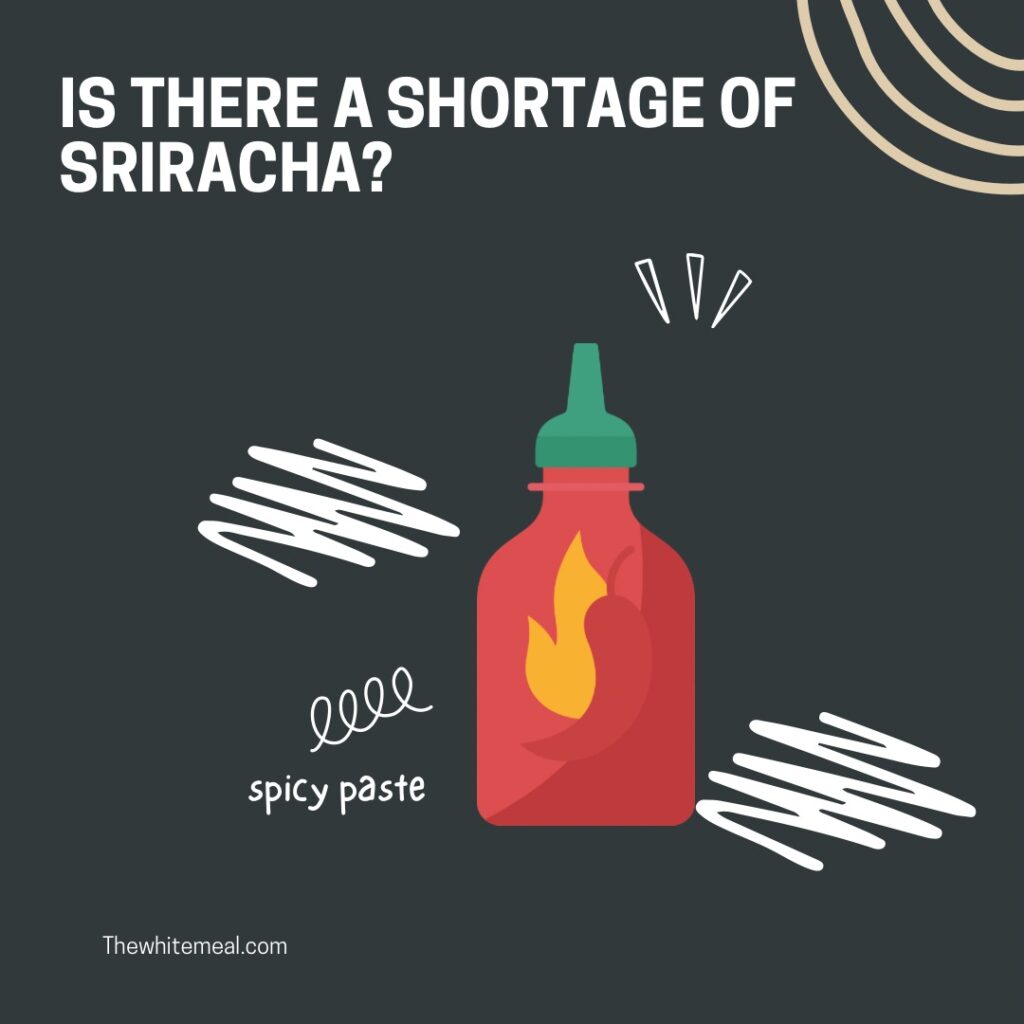Where Did All the Sriracha Sauce Go?
If you’ve been on the hunt for Huy Fon’s famous sriracha sauce, you may have been left scratching your head as you searched high and low at your local grocery store and online retailers.
The sauce seems to have magically vanished from shelves, and it’s leaving us craving and wondering about its sudden scarcity.
In this article, we’ll discuss why this is so and uncover the factors contributing to its limited availability.

Is There Sriracha Shortage in 2023?
While it may seem like there’s a Sriracha shortage going on, the truth is a bit more nuanced.
The most popular and widely recognized brand of Sriracha, Huy Fong, is particularly the one facing some supply chain issues lately.
Huy Fong’s famous peppers, which are integral to their recipe, were in less-than-ample supply last year due to the record-breaking heat and historic drought in the regions where they were usually sourced: Mexico and western United States.
This led to a decrease in manufacturing capacity and a limited, inconsistent supply of their iconic red sauce to distributors.
Because this issue seems mostly confined to the Huy Fong brand, others manufacturers that aren’t as particular about sourcing chilies from Mexico and the Western United States have been able (or since been) outsourcing their peppers from places like Asia.
So while Huy Fong’s Sriracha might be harder to find at the moment, adventurous spice lovers can still get their kicks from other brands such as Lingham’s Sriracha, Eaglobe Sriracha or Pantai Sriracha – depending on individual preference.
What’s The Sriracha Shortage Update (2023)
It has been a rollercoaster ride for sriracha lovers ever since Huy Fong announced the disruption in supply over a year ago.
There was a glimmer of hope when it appeared that production had regained a consistent pace just last fall. However, recent developments have fans of the spicy condiment feeling uncertain again.
Huy Fong has come forward with a less-than-confident announcement regarding their supply stability.
The company cautions distributors not to make any promises to customers unless they physically have sriracha products in their stores.
This means there’s still no clear end in sight for this spicy drought.
For now, it looks like we’re facing another few months of sriracha scarcity.
If you happen to come across the fiery condiment, it’s definitely worth stocking up while you can.
Don’t miss out on your chance to keep those flavorful meals coming — grab those bottles and prepare for an extended shortage!
What Should I Do About The Shortage?
Stock up when you can
While it may be tempting to clear out the shelves at your local grocery store, that isn’t always the most practical solution, be kind enough.
Instead, simply stock up on a reasonable quantity when you have the opportunity and let other people have it too.
Having a few extra bottles in your pantry will ensure that you have enough to last through the shortage without causing undue stress.
Expand your options with alternative Sriracha sauces
Variety is the spice of life, and there are plenty of other great brands that produce their own version of Sriracha sauce. Give these alternatives a try and (possibly) discover new favorites:
- Lingham’s Sriracha
- Kikkoman Sriracha
- Shark Brand Sriracha
- Trader Joe’s Sriracha
- DragonFly Sriracha
- Polar Sriracha
- Eaglobe Sriracha
- Pantai Sriracha
If you can’t get your hands on any of the brands of Sriracha sauce mentioned above, or you particularly do not like the way that some of them taste, you can try out some more distant relatives of Sriracha as an option.
Here are some of them.
Thai Chili
No, we are not asking you to make a paste from raw Thai chilli peppers. A paste of that rawness would be too much for your buds to handle. Thai chillies have a score of 50,000 – 100,000 SHU on the Scoville scale, which means they’re usually Very hot!
Rather, more toned down sauces like Melinda’s Thai Chili sauce offers light heat, like what sriracha does, and then balances this heat with subtle sweetness which makes it a great substitute for sriracha sauce.
Use it as a dip for egg rolls and spring rolls, or as a glaze for roasted Turkey or chicken.
Sambal Oelek
Sambal oelek is also another great substitute for Sriracha sauce. In fact, to ensure you’re not diverting too much from what your buds are used to, you can purchase the sauce from Huy Fong itself — which uses the same jalapeño peppers as the Sriracha sauce, although it may also be difficult to find since the shortage also extend to it as well as the garlic chilli sauce.
Harissa
Harissa is a chilli paste from the northern part of Africa that blends spices and herbs with varieties of peppers such as roasted red peppers Serrano and baklouti. Because different varieties of peppers can be used, harissa typically has varying spice levels.
Use Harissa as sriracha substitutes in applications such as rubbing meat, stews and couscous or pasta.
Gochujang
Gochujang is also another sweet but fermented chilli paste that can serve as a decent replacement for sriracha especially as a marinade for meat, or component in soups and stews.
Piri-Piri Sauce
Originating from Portugal and Africa, this spicy sauce combines fiery bird’s eye chilies with bright citrus flavors for a tangy kick. It is perfect for use as a marinade for meat or as an ingredient for making spreads and dips for chips and toasts.
Make Your Own Sriracha At Home
Lastly, you should consider making a homemade version of sriracha in your kitchen.
You probably have the ingredients at hand, or can easily source them for the project!
Ingredients
- 1 ½ pounds of a mix of red jalapeño peppers and red serrano peppers
- 3 tablespoons light brown sugar
- 2 teaspoons kosher salt
- ½ cup distilled white vinegar
- 3 cloves of garlic, peeled and crushed
Procedure
Start by washing and chopping the red jalapeño and serrano peppers into small pieces. Be sure to remove the seeds for a slightly milder heat or leave them in for an extra fiery kick.
Combine the chopped peppers with the light brown sugar, kosher salt and crushed garlic in the bowl of a food processor, then pulse intermittently until you arrive at a smooth blend.
Transfer this blend into a jar with a loose lid or covered with plastic wrap and allow it to ferment at room temperature for 4 to 7 days, stirring once daily to encourage flavor development.
Once your fermented pepper mixture has reached its peak flavor potential, transfer it into a blender or food processor and add the distilled white vinegar and blend until you achieve a smooth consistency. This is what will help preserve the quality of the paste.
Now strain this liquid through a fine-mesh sieve or cheesecloth to remove any remaining solids.
Pour the mixture into an empty, clean bottle or jar with an air-tight lid. Store it in the refrigerator where it will stay fresh for up to 3 months.

